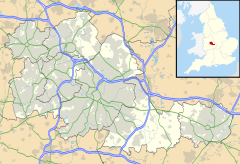1 Lancaster Circus, Birmingham
| 1 Lancaster Circus | |
|---|---|
 1 Lancaster Circus in 2013 | |
| General information | |
| Architectural style | Brutalist style |
| Address | Birmingham, West Midlands |
| Country | United Kingdom |
| Coordinates | 52°29′13″N 1°53′33″W / 52.4869°N 1.8924°W |
| Completed | Early 1970s |
1 Lancaster Circus is a former municipal facility in Birmingham, England. It was the headquarters of West Midlands County Council from its formation in 1974 until its abolition in 1986. The building then served as offices of Birmingham City Council until 2022, when it was closed and sold.
History
The building formed part of an initiative in the 1960s by Birmingham City Council to improve the road infrastructure in the area and to redevelop the city centre.[1] The site selected for development had previously been occupied by the "Perryian Pen Works", a business owned by Perry & Co., which ceased trading on the site in the 1960s.[2][3][4] The factory was demolished in the late 1960s and replaced, briefly, by a motor car and cycle accessory depot.[5]
The conversion of the depot into an office block, which was designed in the brutalist style, was completed in the early 1970s.[6] The design of the new building preserved the shape of the motor depot with a main frontage of 17 bays facing the Lancaster Circus roundabout, and then a long side wing of 34 bays extending along Staniforth Street.[2] The office block served as the headquarters of West Midlands County Council from its formation in April 1974 becoming known as "County Hall".[7][8][9]
Following the abolition of the county council in 1986,[10] the building was renamed 1 Lancaster Circus and occupied, as workspace, by the architecture, engineering, building, finance, environmental and consumer services departments of Birmingham City Council.[11][12] A programme of refurbishment works to convert the building to an open plan layout was undertaken by Wates Group at a cost of £23 million to plans by architects, Urban Design, and completed September 2010.[13][14] The redevelopment, which increased the capacity of the building from 800 occupants to 2,000 occupants and involved the installation of 179 chilled beams,[15] won a regional award from the British Council for Offices in 2011.[16][17]
The city council closed the building and sold it to private investors in 2022.[18]
References
- ^ "Birmingham city centre before the 1960s redevelopment". Royal Institute of British Architects. Retrieved 30 September 2020.
- ^ a b "Ordnance Survey Map". 1956. Retrieved 30 September 2020.
- ^ "The manufacturers". The Pen Room. Archived from the original on 21 March 2012. Retrieved 21 March 2012.
- ^ "Perry & Co". Grace's Guide. 2 October 2020. Retrieved 14 November 2020.
- ^ Bore, Henry (1890). "History of the Perryian Pen Works". Retrieved 1 October 2020.
- ^ "Estate Rationalisation" (PDF). Birmingham City Council. p. 10. Retrieved 7 October 2019.
- ^ The Macmillan Guide to the United Kingdom 1978-79. MacMillan Publishing. 1978. p. 484. ISBN 978-0333199084.
- ^ "No. 48329". The London Gazette. 3 October 1980. p. 13833.
- ^ "The County Council of West Midlands (M6 Motorway Junction 10) (Connecting Road) Scheme 1985". Legislation.co.uk. 2 October 2020. Retrieved 14 November 2020.
- ^ "No. 49121". The London Gazette. 27 September 1982. p. 12502.
- ^ "Lancaster Circus". Birmingham City Council. Retrieved 7 October 2019.
- ^ "Public service management: end of the metropolitan line: county councils face an uncertain future". The Independent. 13 August 1992. Archived from the original on 1 May 2022. Retrieved 14 November 2020.
- ^ "Lancaster Circus Refurbishment Complete". Insider Media. 10 September 2020. Retrieved 14 November 2020.
- ^ "Office revamp opens 20 weeks ahead of schedule". The Business Desk. 15 September 2010. Retrieved 14 November 2020.
- ^ "Birmingham Council's chilled beam landmark". Business Live. 25 June 2009. Retrieved 14 November 2020.
- ^ "Lancaster Circus wins regional BCO Award". Square Dot. 26 May 2011. Retrieved 14 November 2020.
- ^ "Midlands and East Anglia: 1 Lancaster Circus, Birmingham". British Council for Offices. 2011. Retrieved 14 November 2020.
- ^ Jones, Tamlyn (25 April 2023). "Investor reveals plans for former Birmingham council offices". Business Live. Retrieved 16 February 2024.
